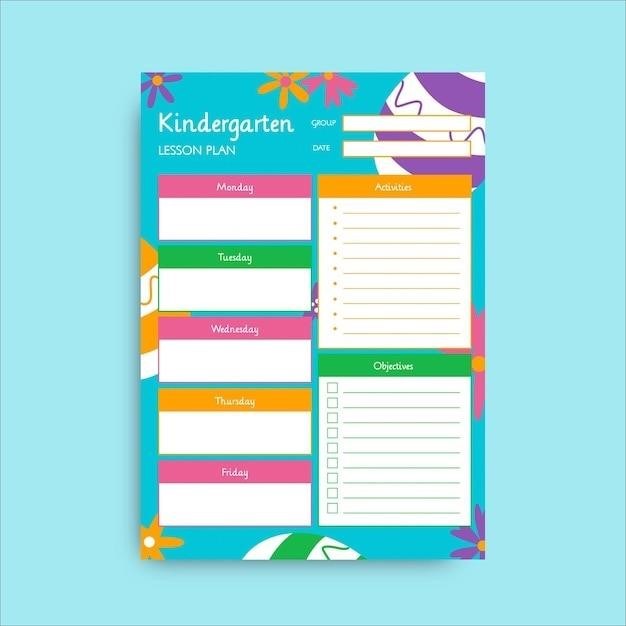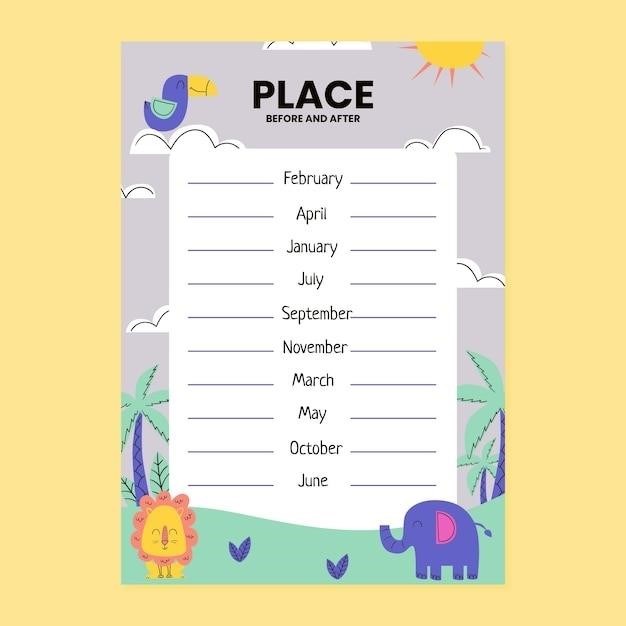Kindergarten End-of-Year Assessment Checklists⁚ An Overview
End-of-year kindergarten checklists offer a valuable tool for evaluating student progress across key academic areas․ These PDFs provide a structured assessment of literacy‚ math‚ and developmental skills‚ aiding teachers in planning future instruction and informing parents․
Types of Kindergarten Checklists
Kindergarten end-of-year checklists vary widely in scope and format․ Some focus solely on academic skills like literacy (letter recognition‚ phonics‚ reading comprehension) and math (number recognition‚ counting‚ basic addition/subtraction)․ Others incorporate developmental milestones‚ encompassing fine motor skills‚ social-emotional development‚ and self-help abilities․ Checklists can be subject-specific (e․g․‚ a dedicated math checklist)‚ comprehensive (covering multiple domains)‚ or aligned with specific curricula like Common Core․ Further distinctions exist between printable PDFs for offline use and digital versions‚ often interactive‚ available online․ The level of detail also varies; some offer simple yes/no options‚ while others include rating scales or space for qualitative observations․ Finally‚ resources range from free‚ downloadable PDFs to paid checklists with more extensive features or aligned to specific state standards․
Assessing Literacy Skills
Kindergarten literacy checklists typically assess foundational skills crucial for future reading success․ These assessments often evaluate letter recognition (uppercase and lowercase)‚ phonics skills (sound-letter correspondence)‚ and phonemic awareness (identifying and manipulating sounds in words)․ Reading comprehension is assessed through simple story retelling or answering basic questions about familiar texts․ Many checklists also include an evaluation of vocabulary development‚ focusing on the child’s ability to understand and use age-appropriate words․ Writing skills may be assessed by examining letter formation‚ the ability to write their name‚ and simple sentence construction․ The specific skills assessed will depend on the checklist used and the curriculum followed․ Some checklists might incorporate informal assessments like observations of reading fluency or engagement with books‚ while others rely on more structured tasks and activities․
Evaluating Math Proficiency
Kindergarten math checklists typically assess number sense‚ counting skills‚ and basic arithmetic operations․ Number recognition (identifying numerals 0-10 and beyond)‚ counting objects accurately‚ and understanding number order are key areas evaluated․ Simple addition and subtraction problems‚ often presented visually with manipulatives or pictures‚ are included to assess early arithmetic skills․ Spatial reasoning and geometry concepts are often tested through shape recognition and the ability to identify simple two-dimensional shapes like circles‚ squares‚ and triangles․ Measurement skills might be evaluated by comparing lengths or quantities․ Finally‚ the understanding of patterns and the ability to continue simple number patterns or sequences is often included․ The specific skills assessed will vary depending on the checklist and the curriculum‚ but they generally aim to gauge a child’s foundational understanding of mathematical concepts essential for future learning․

Utilizing Checklists for Effective Assessment
Kindergarten checklists streamline the assessment process‚ providing a clear overview of student strengths and weaknesses․ They offer valuable data for informing instruction and tailoring future lessons to individual needs․
Benefits of Using Checklists
Employing end-of-year kindergarten checklists offers numerous advantages for both educators and students․ Checklists provide a structured and efficient method for evaluating a child’s progress across various domains‚ including literacy‚ numeracy‚ and social-emotional development․ This organized approach allows teachers to quickly identify areas where students excel and areas requiring further attention‚ facilitating targeted interventions and individualized support․ The data gathered from checklists aids in creating effective learning plans tailored to each child’s unique learning style and pace․ Furthermore‚ checklists provide valuable documentation for parents‚ offering insights into their child’s academic journey and progress throughout the year․ This transparent communication fosters collaboration between home and school‚ strengthening the support system surrounding the child’s development․ The objective nature of checklists minimizes subjective biases‚ ensuring a fair and accurate assessment of each student’s capabilities․ Finally‚ the use of checklists simplifies the often complex task of evaluating a diverse range of skills in young learners‚ contributing to a more streamlined and manageable assessment process for educators․
Integrating Checklists into Curriculum Planning
Effectively integrating end-of-year kindergarten checklists into curriculum planning enhances instructional effectiveness and ensures a cohesive learning experience․ By analyzing the data gleaned from checklists‚ teachers can pinpoint areas where students demonstrate mastery and those requiring further instruction․ This targeted approach allows for the strategic adjustment of future curriculum‚ ensuring that subsequent lessons address identified learning gaps and build upon existing strengths․ The checklist data informs the selection of appropriate teaching methods and resources‚ enabling teachers to tailor their instruction to meet individual student needs․ For example‚ if a checklist reveals widespread difficulty with a particular math concept‚ the teacher can dedicate more time and resources to that area in the next academic year․ Furthermore‚ checklists facilitate the alignment of instruction with learning objectives and standards‚ promoting a focused and goal-oriented curriculum․ This data-driven approach promotes continuous improvement in the curriculum‚ leading to better student outcomes and a more robust and responsive educational program․ The iterative process of assessment and curriculum revision‚ using checklists as a key tool‚ ultimately creates a dynamic and adaptable learning environment that caters to the diverse needs of all kindergarten students․
Using Assessment Data to Inform Instruction
Kindergarten end-of-year checklists provide invaluable data to inform future instructional decisions․ Analyzing the results reveals individual student strengths and weaknesses‚ allowing teachers to tailor their teaching methods and curriculum accordingly․ For instance‚ if a checklist shows a student struggling with letter recognition‚ the teacher can implement targeted interventions‚ such as phonics games or one-on-one tutoring․ Similarly‚ if many students struggle with a particular math concept‚ the teacher can adjust their lesson plans to provide more focused instruction and utilize different teaching strategies․ This data-driven approach ensures that instruction is differentiated to meet the specific needs of each learner․ Moreover‚ the assessment data can inform the selection of appropriate educational materials and resources․ The teacher might choose to incorporate additional practice worksheets‚ online learning platforms‚ or manipulatives to support students in areas where they need extra help․ By carefully reviewing and interpreting the checklist information‚ teachers can create a more effective and personalized learning experience for every child‚ fostering a stronger foundation for future academic success․

Accessing and Utilizing Kindergarten Checklist PDFs
Numerous free and paid kindergarten checklist PDFs are readily available online․ Teachers can find resources aligned with Common Core standards to efficiently assess student learning and inform instructional planning․
Free and Paid Resources
The availability of kindergarten end-of-year assessment checklists varies widely․ Many websites offer free downloadable PDFs‚ often including simple checklists focusing on basic literacy and numeracy skills․ These free resources can be a great starting point for teachers with limited budgets or those needing a quick assessment tool․ However‚ the scope and depth of these free checklists may be limited compared to paid options․ Paid resources‚ frequently found on educational marketplaces like Teachers Pay Teachers‚ often provide more comprehensive assessments․ These might include detailed checklists covering a broader range of skills‚ aligned with specific curriculum standards (such as Common Core)‚ and sometimes even offer additional features like answer keys or data analysis tools․ The cost varies considerably depending on the features and comprehensiveness of the checklist․ Ultimately‚ the choice between free and paid resources depends on the individual teacher’s needs and budget‚ considering the desired level of detail and assessment features․ Careful comparison of available options is advised to ensure a proper fit for classroom needs․
Finding Checklists Aligned with Common Core Standards
For educators committed to the Common Core State Standards‚ locating assessment checklists aligned with these guidelines is crucial․ Many commercially available kindergarten end-of-year checklists explicitly state their alignment with Common Core‚ making identification straightforward․ Look for keywords like “Common Core aligned‚” “CCSS‚” or specific references to the relevant kindergarten standards (e․g․‚ K․CC․A․1‚ K․OA․A․1) within the checklist descriptions․ However‚ simply stating alignment isn’t enough; a thorough review of the checklist’s content is necessary to ensure actual alignment․ Carefully examine the skills assessed to verify they accurately reflect the Common Core expectations for kindergarten․ Free resources may sometimes lack this explicit alignment‚ requiring more effort to cross-reference the skills with the official standards․ Online marketplaces and educational publishers are valuable resources for finding commercially produced checklists that clearly and accurately reflect Common Core requirements for kindergarten․ Utilizing these resources ensures assessments accurately gauge student mastery of the essential skills outlined in the standards․
